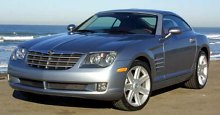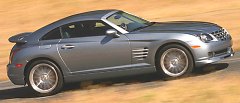 Designed
in America, named as a Chrysler, but engineered by Mercedes and
assembled
in Germany by Karmann. Is it an American car, or a German car, or an
American-German
car? Chrysler admitted it is developed base on Mercedes SLK and
employed
39% Mercedes components, so, is that meaning the remaining 61% content
is American, like some American magazines said? No. With a bit common
sense
and a bit understanding about how car industry work, you will know the
non-Mercedes parts are either made by Karmann itself or supplied by
mostly
European suppliers. Crossfire is strictly a German car. Designed
in America, named as a Chrysler, but engineered by Mercedes and
assembled
in Germany by Karmann. Is it an American car, or a German car, or an
American-German
car? Chrysler admitted it is developed base on Mercedes SLK and
employed
39% Mercedes components, so, is that meaning the remaining 61% content
is American, like some American magazines said? No. With a bit common
sense
and a bit understanding about how car industry work, you will know the
non-Mercedes parts are either made by Karmann itself or supplied by
mostly
European suppliers. Crossfire is strictly a German car.
The concept was born in 2001 Detroit Motor Show, well received by the public thus immediately got greenlight for production. The stunning look of Crossfire was penned by Andrew Dyson in America. It follows Tom Gale’s school of radical, emotional yet retro styling theme which brought Viper, Prowler and PT Cruiser straight into production. However, the Crossfire’s shape is more practical, less nonsense for production than the aforementioned cars. Under the hands of German engineers, it was further rationalised. Anyway, this is still one of the most stunning-looking production car you can see on the road. To save money and cut development time, Crossfire is built on the Mercedes SLK floorpan. This seems not very promising, because the SLK is now 7 years old and is to be replaced next year. The Chrysler version shares the same 2400mm wheelbase and is merely longer, wider and taller by a whisky. That guarantees the engineering work is relatively easy. However, one thing giving it an upper hand over the Mercedes sister car - its closed roof make the chassis a lot stiffer than the SLK.
So, is it a coupe version of SLK? surprisingly, the Chrysler version is superior in dynamics. It is simply better than SLK320 in every way. For example, the V6’s installation is better, smoother and generates sexier exhaust resonance. Suspensions make better use of the stiff chassis and provide a more compliant ride yet crisper body control. Even the traditionally dull recirculating-ball steering system now delivers plenty of feedback. Mercedes’s engineers seemed save nothing for themselves and do all they know to improve every area of the SLK platform. The down side? the Mercedes 3-valve V6 starts showing age now by the way it respond to throttle input. It is still smooth and delivers plenty of torque, but BMW and Audi build better 6-cylinder engines. Besides, brake feel is numb. However, the biggest flaw is the 6-speed manual gearbox. Like that in the Mercedes applications, shift action is rubbery. The 5-speed automatic is a much better choice.
Is it our cup of
tea? I’m
afraid not. The 1388kg Crossfire powered by a 215hp engine accelerates
from 0-60mph in 6.5 seconds, far slower than Z4 3.0 (5.4 sec) and 350Z
(5.4 sec) and edged out by Audi TT V6 (6.1 sec). Its engine is
relatively
civilised and performance is relatively relaxed. While handling is
fine,
you can’t (or you won’t) enjoy shifting gears by yourself. Moreover,
beside
a Mazda RX-8 it seems overpriced and not good enough.
|
| The above report was last updated on 7 Apr 2003. All Rights Reserved. |
 Sharing
an old Mercedes platform is not necessarily a bad thing, you know,
because
Mercedes is Mercedes while Chrysler is just Chrysler. If it were by
Chrysler
itself, will the Crossfire get a rear-drive layout? or a lightweight
215hp
3.2-litre V6? what about a 6-speed gearbox and a world-class 5-speed
automatic?
will it get double wishbones front and multi-link rear suspensions?
undoubtedly,
most of the answers would have been "No" if it were done by Chrysler.
Sharing
an old Mercedes platform is not necessarily a bad thing, you know,
because
Mercedes is Mercedes while Chrysler is just Chrysler. If it were by
Chrysler
itself, will the Crossfire get a rear-drive layout? or a lightweight
215hp
3.2-litre V6? what about a 6-speed gearbox and a world-class 5-speed
automatic?
will it get double wishbones front and multi-link rear suspensions?
undoubtedly,
most of the answers would have been "No" if it were done by Chrysler.
 What
will it rival with? Audi TT is most obvious, then there are BMW Z4, SLK
itself and Nissan 350Z. As the Crossfire is built in Germany, actually
in the same line where Karmann used to build SLK, it won’t be as cheap
as the Chrysler name suggest. Expect it to cost the same as the 225hp
Audi
TT in Europe. The good side is that build quality is German-grade.
What
will it rival with? Audi TT is most obvious, then there are BMW Z4, SLK
itself and Nissan 350Z. As the Crossfire is built in Germany, actually
in the same line where Karmann used to build SLK, it won’t be as cheap
as the Chrysler name suggest. Expect it to cost the same as the 225hp
Audi
TT in Europe. The good side is that build quality is German-grade.
 As
the standard Chrysler Crossfire was derived from Mercedes SLK320, it
can
also receive the same engine as the outgoing SLK32 AMG. This is the
supercharged
version of the 3.2 V6. It employs a very good helical type supercharger
made by IHI. The aluminum supercharger is installed neatly into the
V-valley
thus takes virtually no extra space. In Mercedes form, it generated 349
horsepower and 332 lbft of torque. In the Crossfire SRT-6 (in which SRT
stands for "Street and Racing Technology" while 6 is the cylinder
count),
it is detuned to 330hp and 310lbft due to whatever reasons only
DaimlerChrysler
knows. Despite that, it is still a full one hundred horsepower up from
the standard Crossfire.
As
the standard Chrysler Crossfire was derived from Mercedes SLK320, it
can
also receive the same engine as the outgoing SLK32 AMG. This is the
supercharged
version of the 3.2 V6. It employs a very good helical type supercharger
made by IHI. The aluminum supercharger is installed neatly into the
V-valley
thus takes virtually no extra space. In Mercedes form, it generated 349
horsepower and 332 lbft of torque. In the Crossfire SRT-6 (in which SRT
stands for "Street and Racing Technology" while 6 is the cylinder
count),
it is detuned to 330hp and 310lbft due to whatever reasons only
DaimlerChrysler
knows. Despite that, it is still a full one hundred horsepower up from
the standard Crossfire.
 The
SRT-6 gets much stiffer suspensions setup than the standard Crossfire -
spring rate has been increased by 50% and 42% front and rear
respectively.
Damping rate increased 40%. That compensates the narrow tracks and high
center of gravity, but in the price of ride quality. On broken
surfaces,
it can rock you eyeballs off. Low speed ride is so poor that it feels
as
if the wheels are connected rigidly to the chassis. We hope it could be
tuned softer, but who knows by then whether it can handle the extra 100
horsepower yet maintaining tight body control? remember, this chassis
is
based on an outdated Mercedes design. It is a full generation behind
the
current Mercedes SLK.
The
SRT-6 gets much stiffer suspensions setup than the standard Crossfire -
spring rate has been increased by 50% and 42% front and rear
respectively.
Damping rate increased 40%. That compensates the narrow tracks and high
center of gravity, but in the price of ride quality. On broken
surfaces,
it can rock you eyeballs off. Low speed ride is so poor that it feels
as
if the wheels are connected rigidly to the chassis. We hope it could be
tuned softer, but who knows by then whether it can handle the extra 100
horsepower yet maintaining tight body control? remember, this chassis
is
based on an outdated Mercedes design. It is a full generation behind
the
current Mercedes SLK.